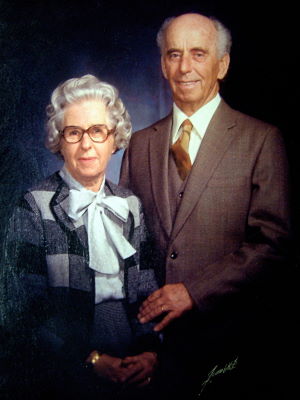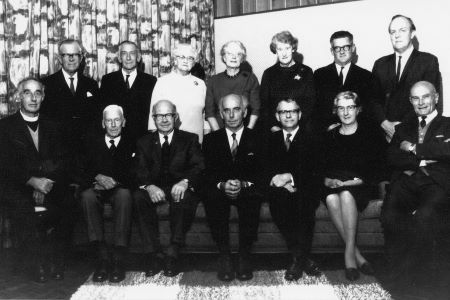
Young men have always seen visions and dreamed dreams, and the world is a better place because of those dreams. One such young man was Lloyd Parker (born 30 June 1914). His vision was of beautiful gardens, which led to an almost professional knowledge of horticulture. That, together with his commitment to his career as a builder and his developing concern regarding the needs of people growing older in a sometimes uncaring society, produced the outstanding man we recall today – the man who founded Parkwood, New Zealand’s most beautiful retirement village.
Lloyd was supported by his wife Joan, a gracious lady who was knowledgeable of the needs of older people through her active involvement in charity work for the Red Cross. Joan’s support for Lloyd was also well demonstrated by the fact that all meetings and the occasional social function were held in their home until well into the development of the project.
Lloyd Parker was an interesting man, self-made and highly successful. Although at times brusque and certainly someone who had no time for pretension of any kind, beneath a crusty exterior he was a man who had deep concern for others – particularly the elderly and the circumstances in which many found themselves in older age. He felt very strongly and often expressed the view that everyone was entitled to live out their later years in a peaceful environment among friends and to be cared for by persons who would respect their dignity.
Lloyd had the good fortune to have a number of business colleagues who shared his vision. They included Ray Spackman, professional accountant and a driving force in the formation of Coastlands Shoppingtown; George Hodgson, contractor and entrepreneur; Vern Grace, successful and highly regarded civil engineer; and Geoffrey Thompson, a young lawyer resident in the area who later became a Member of Parliament for the district.
On 9 August 1967 Lloyd called a meeting in Waikanae, convened by the Presbyterian Church, the stated object of which was to “explore the possibility of building accommodation in Waikanae for aging people”. Those attending the meeting represented the Anglican, Presbyterian, Roman Catholic and Methodist Churches and seven other community services. A committee was formed and various situations pertinent to the objectives explored, including visiting rest homes for the elderly, looking at possible sites and discussing types of houses with an architect, as well as investigating what services (ie social services) were available at national, regional and local levels.
A site considered suitable was found comprising 18½ acres, of which 12 acres were pastoral and the remainder was bush. The site was bordered by Sylvan Avenue and necessitated the purchase of a strip of land five feet wide to give access to Sylvan Avenue.
Ongoing and in depth discussions were held as to what types of dwellings were suitable and how the purchase of the land and of individual homes would be financed. Strong views emerged that prospective residents would (with rare exceptions) wish to own their own home without recourse to government or other sources of finance.
Eventually bank loans became available, but these had to be guaranteed. Members of the committee did so, thus facilitating the loan for the land. The site was named ‘Parklands’ and a well-respected town planner prepared plans for the development of the proposed village. In the meantime, ways of developing the individual houses continued and personal funding of the residences evolved.

Front row: Canon N Williams (Hon Newsletter Editor), H G C Simmons, W J E V Grace (Hon Manager Secretary), H L Parker (Chairman), C R Spackman (Hon Treasurer), Mrs D Milne, A M Hollings (Hon Solicitor)
The Parklands Committee developed a scheme whereby the land was held in trust whilst allowing prospective residents to build or buy a dwelling place and common services. Legally the prospective residents obtained a licence to occupy the land, but owned their own home. That was done by individuals or couples making a “donation”. In order to comply with external financial laws and regulations, it was necessary for the existing committee to register as a charitable trust, and it was considered desirable to have a legally qualified member on the Trust Board. Assurances were also obtained from Palmerston North Hospital Board that their community support resources (district nursing care, meals on wheels, etc) would be available.
A brochure was prepared and widely circulated locally. It contained an application form, completion of which allowed the individual to make their “donation”, choose a site and proceed with building a house. The Trust withheld a fixed sum that was used to further the general development of the village. In addition, two committee members underwrote the building of two villas on a speculative basis to show in real terms the committee’s intentions. In 1969 the committee disbanded in order that a charitable trust could be formed, as members were now handling relatively large sums of money without any motivation of personal gain. The first formal meeting of the Board of Management of the Parklands Trust was held in September 1969.
This section has been adapted from A Place called Parkwood, by Margaret Lythgoe, a history of Parkwood published in 2007.
